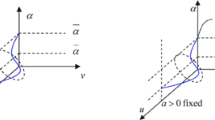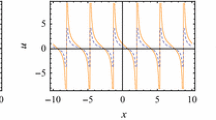Abstract
Models of biological development, evolution and control should take into account that very small numbers of cells or chemicals or individuals eventually grow into stable, large populations. The simplified two-component model used in these studies includes the following: (1) first-order decay; (2) first-order autocatalysis; (3) negative feedback; (4) positive feedback; (5) second-order decay; (6) second-order autocatalysis. A positive definite Lyapunov function is constructed and shown to have a negative definite total derivative. The stationary statex>0,y>0, therefore possesses global asymptotic stability. This means that sustained oscillations cannot occur. Another stationary state,x=y=0, is shown to be unstable. This means that infinitesimally small perturbations ofx=y=0 will result in evolution of the variables to the stable stationary state. This result contrasts with that obtained with the Lotka-Volterra model in that small perturbations ofx=y=0 for that model result in sustained, oscillating excursions; the smaller the initial perturbations, the larger these excursions will be.
A simulation illustrates that stable populations of 1020 x's andy's can arise from a singlex andy.x grows more or less continuously, buty remains extremely small for 80 per cent of the time interval required for the variables to approach their stable populations.
Similar content being viewed by others
Literature
Barashin, E. A. and N. N. Krasovsky. 1952.Dokl. Akad. Nauk SSSR 36, 3. (In Russian.)
Lotka, A. 1910. “Contribution to the Theory of Periodic Reactions.”J. Phys. Chem. 14, 271.
Volterra, V. 1931.Theorie Mathematique de la Lutte pour la Vie. Paris: Gauthiers-Villars.
Walter, C. 1972. “Kinetic and Thermodynamic Aspects in Biological and Biochemical Control Mechanisms.” InBiochemical Regulatory Mechanisms in Eukaryotic Cells. New York: Wiley, p. 394.
Walter, C. 1973. “Global Asymptotic Stability of Prey-Predator Systems With Second-Order Dissipation.”Adv. Chem. Phys. (In Press.)
Author information
Authors and Affiliations
Additional information
Proceedings article from the Dissipative Structures section of the Tenth Symposium on Biomathematics and Computer Science in the Life Sciences, University of Texas, Houston. March 29–31, 1973. Symposium Chairman: Stuart O. Zimmerman. Session Chairman and Proceedings Editors: Charles Walter and Hugo M. Martinez.
Rights and permissions
About this article
Cite this article
Walter, C. The global asymptotic stability of prey-predator systems with second-order dissipation. Bltn Mathcal Biology 36, 215–217 (1974). https://doi.org/10.1007/BF02458605
Issue Date:
DOI: https://doi.org/10.1007/BF02458605




